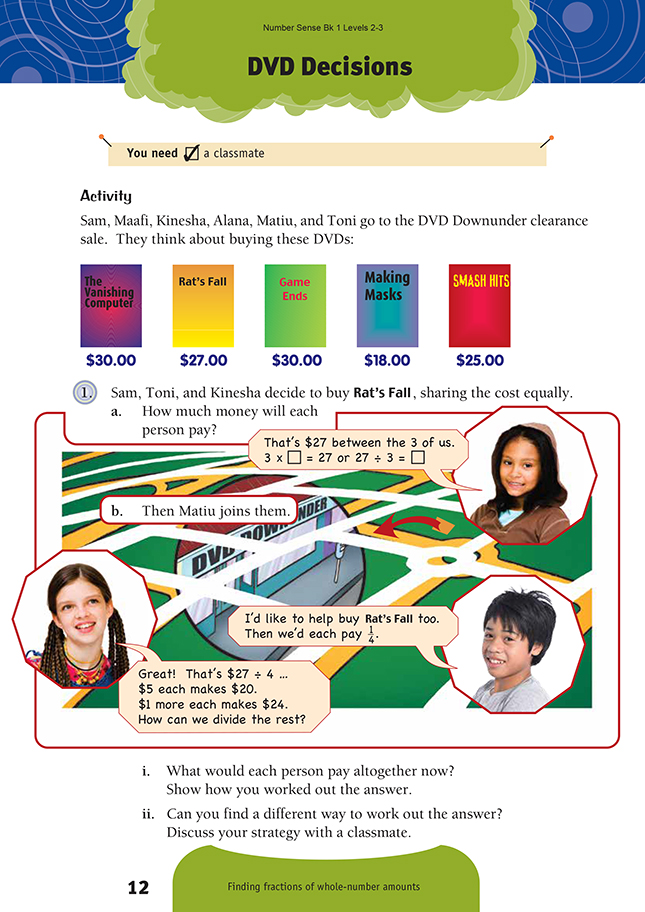This is a level 3 number activity from the Figure It Out series. It relates to Stage 6 of the Number Framework.
Click on the image to enlarge it. Click again to close. Download PDF (170 KB)
find fractions of money amounts
Number Framework Links
Use this activity and investigation to:
• help the students who are beginning to use early additive strategies (stage 5) to become confident at this stage in all three operational domains (addition and subtraction, multiplication and division, and proportions and ratios)
• encourage transition from early additive strategies (stage 5) to advanced additive strategies (stage 6).
FIO, Levels 2-3, Number Sense and Algebraic Thinking, Book One, DVD Decisions, page 12
A classmate
By combining the money context with different numbers of friends sharing costs, this activity allows a variety of strategies to be used with subtraction, division, and fractions.
The students at stage 6 (advanced additive) or above could attempt this activity independently in groups and report back.
Introduce this activity to a guided teaching group by pointing out that the DVD prices have been rounded up to a tidy dollar amount even though shops almost always price them at so many dollars and 95 cents. This rounding enables the students to calculate the shared costs better because we cannot split 5 cents in real money.
Introduce or revise , , and of $1.00 as 25 cents, 50 cents, and 75 cents respectively. These facts will be useful in solving some problems. The students could record these with other facts that they need to memorise.
The students who need to use materials could act out the scenarios in each question with play money and a card representing each DVD. When they report back, discuss different ways to split the cost equally. Ideas may include sharing out dollars in units of $1, $5, or $10 notes, one at a time, and then sharing out coins in the same way, as needed, to meet the price.
For imaging, have the students pretend that their money is being carried by an adult and that they have to ask for the notes and coins they will use to buy each DVD. They receive the money after they have solved the sharing problem by imaging the money they need.
To encourage the students to use number properties, put them in small groups and ask them to find and share different ways of using and recording numbers and operations to solve the problems.
Highlight the connections between ideas. For example, question 1 can be solved by having the three friends sharing out $5, $5, and $5, then $2, $2, and $2, and finally, $2, $2, and $2 again while they keep a running total. The students who know x 3 = 27 should see that this is the same as sharing out $9, $9, and $9.
Question 1b provides an opportunity to discuss and reinforce the connection between $27 ÷ 4 and finding 1/4 of $27. Students don’t automatically understand that dividing by a number and multiplying by its inverse (reciprocal) are just two different ways of viewing the same thing. (Dividing by 4 is accessible to early additive students if they use halving and halving.)
When students see that dividing by 4 has the same effect as multiplying by and vice versa, create a pattern by extending this to dividing by 2 and multiplying by and other pairs of reciprocals, such as 1/3 and 3. Encourage the students to describe the pattern.
Investigation
Remind the students before they begin the investigation to round the cost of the DVDs to the nearest whole dollar
Answers to Activity
1. a. $9
b. i. $6.75. Methods will vary. Continuing Kinesha’s thinking, you could say $3 is
the same as $4 – (4 x 25c), so of the $3, each person pays $1 – 25c or 75c.
$5 + $1 + 75c = $6.75
ii. Strategies will vary. For example:
$28 ÷ 4 = $7, and $1 ÷ 4 = 25c. $27 = $28 – $1, so 1/4 of $27 is $7 – 0.25c, which is $6.75
Another strategy is 8 + 8 + 8 + 3 = 28. 1/4 of each of these bits is
2 + 2 + 2 + 0.75 = 6.75
2. $27.50. One way to work this out is:
30 + 25 = $55. 55 ÷ 2 = $27.50. Another way is to work out of 30 + of 25.
15 + 12.50 = $27.50
3. $24. (32 ÷ 4 = 8. 32 – 8 = 24 or 30 – 10 + 4 = 24)
4. a. $9. (39 – 30)
b. Answers will vary. For example, she could pay for 1/2 of Making Masks with 1 other. If Alana doesn’t mind paying more than the others, she could pay $9 towards a video, and her friends could share the rest. For example, she could pay $9 towards Smash Hits, and 2 of the others could pay $8 each (9 + 8 + 8 = $25).
Investigation
Results will vary.

